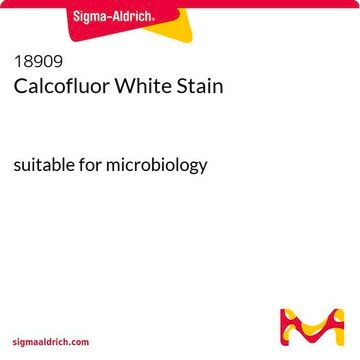As mentioned in the 'PROPERTIES' section, this product is supplied as a powder.
Wichtige Dokumente
C6767
Kongorot
Dye content ≥35 %, Powder
Synonym(e):
Direktrot 28, Kongorot 4B
Größe auswählen
About This Item
Empfohlene Produkte
Produktbezeichnung
Kongorot, Dye content ≥35 %
Form
powder
Qualitätsniveau
Zusammensetzung
Dye content, ≥35%
Methode(n)
titration: suitable
Farbe
red-brown
pH-Wert
6.7 (10 g/L)
mp (Schmelzpunkt)
>360 °C (lit.)
Löslichkeit
H2O: 1 mg/mL
Anwendung(en)
diagnostic assay manufacturing
hematology
histology
Lagertemp.
room temp
SMILES String
[Na+].[Na+].Nc1c(cc(c2ccccc12)S([O-])(=O)=O)\N=N\c3ccc(cc3)-c4ccc(cc4)\N=N\c5cc(c6ccccc6c5N)S([O-])(=O)=O
InChI
1S/C32H24N6O6S2.2Na/c33-31-25-7-3-1-5-23(25)29(45(39,40)41)17-27(31)37-35-21-13-9-19(10-14-21)20-11-15-22(16-12-20)36-38-28-18-30(46(42,43)44)24-6-2-4-8-26(24)32(28)34;;/h1-18H,33-34H2,(H,39,40,41)(H,42,43,44);;/q;2*+1/p-2/b37-35+,38-36+;;
InChIKey
IQFVPQOLBLOTPF-HKXUKFGYSA-L
Suchen Sie nach ähnlichen Produkten? Aufrufen Leitfaden zum Produktvergleich
Anwendung
- Congo red has been used as a histochemical stain for the quantification of amyloid deposits in brain tissues.[1]
- It has been used as a cell wall inhibiting agent in fungus Cryptococcus neoformans.[2]
- It has also been used to study microstructural details in the cell walls of raw potato and fried potato using confocal microscopy.[3]
Biochem./physiol. Wirkung
Signalwort
Danger
H-Sätze
Gefahreneinstufungen
Carc. 1B - Repr. 2
Lagerklassenschlüssel
6.1C - Combustible acute toxic Cat.3 / toxic compounds or compounds which causing chronic effects
WGK
WGK 3
Persönliche Schutzausrüstung
Eyeshields, Gloves, type P3 (EN 143) respirator cartridges
Zulassungslistungen
Zulassungslistungen werden hauptsächlich für chemische Produkte erstellt. Für nicht-chemische Produkte können hier nur begrenzte Angaben gemacht werden. Kein Eintrag bedeutet, dass keine der Komponenten gelistet ist. Es liegt in der Verantwortung des Benutzers, die sichere und legale Verwendung des Produkts zu gewährleisten.
EU REACH SVHC Candidate List
EU REACH Annex XVII (Restriction List)
Hier finden Sie alle aktuellen Versionen:
Besitzen Sie dieses Produkt bereits?
In der Dokumentenbibliothek finden Sie die Dokumentation zu den Produkten, die Sie kürzlich erworben haben.
Kunden haben sich ebenfalls angesehen
-
hello, I would like to ask about this product, is it a powder or solution? thank you.
1 Antwort-
Hilfreich?
-
-
Why does the SDS for Congo Red list carcinogen as an OSHA hazard, (Section 2) but in Section 11 on carcinogenicity, it states that there is no component identified as a carcinogen?
1 Antwort-
The reason that there is not an OSHA listing for carcinogens on most of SDS that have a hazard of a carcinogen hazard is because that section of the SDS is specifically for the OSHA regulated carcinogens, also referred to as the OSHA 13. Congo red at this time is not specifically called out as a carcinogen by the other 3 Organizations listed (IARC, NTP, ACGIH) either. Congo red is listed by the European Classification Labeling & Packaging (CLP) Regulation (which is a pretty definitive guide for hazard classification), as a carcinogen. No other organizations have had the time to classify this material at this time. This is why it is only listed as a carcinogen in section 2 and in section 15.
Hilfreich?
-
-
What is the Department of Transportation shipping information for this product?
1 Antwort-
Transportation information can be found in Section 14 of the product's (M)SDS.To access the shipping information for this material, use the link on the product detail page for the product.
Hilfreich?
-
Aktive Filter
Unser Team von Wissenschaftlern verfügt über Erfahrung in allen Forschungsbereichen einschließlich Life Science, Materialwissenschaften, chemischer Synthese, Chromatographie, Analytik und vielen mehr..
Setzen Sie sich mit dem technischen Dienst in Verbindung.








